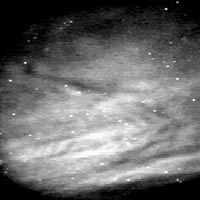|
Leonid MAC |
| home |
| View the shower |
| Mission Brief |
| Science Update |
| Media Brief |
| links |
LEONID DAILY NEWS: November 7, 2000
METEORS AFFECT ATMOSPHERIC CHEMISTRY
The 1999 Leonid meteor storm had a positively glowing effect on the Earth's atmosphere!
In the upcoming issue of Earth, Moon and Planets, Joe Kristl
and colleagues of Stewart Radiance Laboratory report that the night time OH airglow
became 30 percent brighter during the storm.
Meteors interact with the Earth's atmosphere in a region called the upper mesosphere
and lower thermosphere, between 70 and 130 km altitude. That is also where a faint
natural night glow is observed, arising from chemical reactions of upper atmospheric
molecules and atoms. The light is particularly bright in the near-Infrared, where
the hydroxyl radical OH emits strongly. That emission orginates from the reaction of
ozone (O3) and hydrogen atoms (H).
The OH airglow shows up well in this vivid image of the night-time sky by
Mike J. Taylor
and Larry C. Gardner of Utah State University.
The image was obtained by tuning a camera with
a field of view of about 20 degrees
to the specific colors of OH airglow emission (0.9-1.6 micron).
The airglow shows up as bright cirrus-cloud like structures.
The image shows the wealth of structures that are caused by atmospheric gravity waves propagating through
the OH nightglow emission layer (altitude ~87 km).
The InGaAs camera was on loan from NRL, the Navy
Research Labs., and mounted at low elevations on the FISTA aircraft.
Graphs showing the intensity of OH airglow (top) and the meteor activity (below) during the
night of November 18, 1999.
Meteors can be a source of ozone as well as hydrogen and several researchers made an
effort to see if the Leonid meteor storm had any effect on the night time airglow.
Now, Kristl and coworkers report that
the OH emission did increase during the Leonid storm, but following closely the meteor activity.
Kristl made the measurements with a Bomen Michelson interferometer of the AFRL "FISTA"
program as part of an extensive set of infrared (1.00-1.65 micron) airglow measurements
collected onboard the USAF FISTA aircraft.
The change in airglow intensity was only apparent for OH emission, not for the molecular
oxygen emission at 1.27 micron recorded with the same instrument.
Also, no changes were observed in the airglow intensity of sodium emission by Noah Brosch
and Ohad Shemmer at Wise Observatory in nearby Israel.
And no similar OH airglow
increase was observed during the other nights of the Leonid Multi-Instrument
aircraft campaign.
Despite some plausible mechanisms, the observation comes as a surprise.
At what altitude
did the OH brighten?
Few Leonids penetrate as deep as the usual OH airglow layer. Was it the increase of
ozone, oxygen atoms, or the production of hydrogen that caused the effect? If it was hydrogen,
then organic matter in the meteoroids may be indirectly responsible.
Worse, with only one case study in hand, we can
not be certain that the meteor storm was responsible for the observed increase.
Gravity waves and tides can change the OH emission as well, the nice correlation with the
time of the storm being perhaps just coincidence. Not until further
Leonid storm encounters can we be certain (Full paper -PDF).
Nov. 07 - Meteors affect atmospheric chemistry Nov. 06 - Listen to this! Nov. 04 - Fear of heights? Nov. 03 - The pale (infra-red) dot Nov. 02 - Twin showers Nov. 01 - Leonids approaching Earth Oct. 31 - Prospects for Moon Impact Studies Oct. 30 - Comet dust crumbled less fine
| ||

 Figure left: One of many images of airglow taken during the Leonid MAC mission.
Figure left: One of many images of airglow taken during the Leonid MAC mission.

